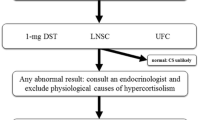Summary
We evaluated the usefulness of the basal urinary 24-h excretion rates of free cortisol versus 17-hydroxycorticosteroids in the diagnosis of Cushing's syndrome. On an outpatient basis, both urinary free cortisol and 17-hydroxycorticosteroids levels were determined in 48 patients with Cushing's syndrome, as well as in 95 obese and 94 healthy control persons of normal weight. Determination of the urinary free cortisol content allowed a clear-cut distinction between the patients with hypercortisolism and the controls, resulting in a sensitivity of 100% and specificity of 98% for the diagnosis of Cushing's syndrome. The diagnostic accuracy of urinary free cortisol was distinctly superior to that of 17-hydroxycorticosteroids, which showed a wide overlap of values between the groups, with a sensitivity of 73% and a specificity of 94%. In conclusion, the measurement of basal urinary free cortisol provided an excellent diagnostic sensitivity and specificity in the assessment of adrenocortical function. This simple and accurate test thus seems to be particularly useful in the outpatient evaluation of patients with suspected Cushing's syndrome.
Similar content being viewed by others
Abbreviations
- 17-OHCS:
-
17-hydroxycorticosteroids
- ACTH:
-
adrenocorticotropic hormone
- BMI:
-
body-mass index
- UFC:
-
urinary free cortisol
References
Baxter JD, Tyrell JB (1987) The adrenal cortex. In: Felig P, Baxter JD, Broadus AE, Frohman LA (eds) Endocrinology and metabolism. McGraw Hill, New York, pp 511–650
Burke CW, Beardwell CG (1973) Cushing's syndrome. An evaluation of the clinical usefulness of urinary free cortisol and other urinary steroid measurements in diagnosis. QJ Med 42:175–204
Crapo L (1979) Cushing's syndrome: a review of diagnostic tests. Metabolism 28:955–977
Eddy RL, Jones AL, Gilliland PF, Ibarra JD, Thompson JQ, McMurry JF (1973) Cushing's syndrome: a prospective study of diagnostic methods. Am J Med 55:621–629
Hellmann L, Nakada F, Curti J (1970) Cortisol is secreted episodically by normal man. J Clin Endocrinol Metab 300:411–422
Larsen LJ, Cathey W, Odel WD (1986) Primary nodular adrenocortical dysplasia, a distinct subtype of Cushing's syndrome. Am J Med 80:976–984
Mengden T, Vetter H, Marincek B, Edmonds D, Jeck T, Schubert M, Vetter W (1989) Rational diagnosis of endocrine forms of hypertension. Imaging 56:132–140
Meikle AW (1989) Secretion and metabolism of the corticosteroids and adrenal function and testing. In: DeGroot LJ (ed) Endocrinology. Saunders, Philadelphia, pp 1610–1632
Migeon CJ, Green OC, Eckert JP (1963) Study of adrenocortical function in obesity. Metabolism 12:718–739
Murphy BEP (1968) Clinical evaluation of urinary cortisol determinations by competitive protein-binding radioassay. J Clin Endocrinol 28:343–348
Murphy BEP, Okouneff LM, Klein GP, Ngo SC (1981) Lack of specificity of cortisol determination in human urine. J Clin Endocrinol Metab 53:91–99
Nelson DH (1989) Cushing's syndrome. In: DeGroot LJ (ed) Endocrinology. Saunders, Philadelphia, pp 1660–1675
Neville AM, O'Hare MJ (1979) Aspects of structure, function and pathology. In: James VHT (ed) The adrenal gland. Raven Press, New York
Peterson RE, Wyngaarden JB, Guerra SL, Brodie BB, Bunim JJ (1955) The physiological disposition and fate of hydrocortisone in man. J Clin Invest 34:1779–1794
Ross EJ, Linch DC (1982) Cushing's syndrome-killing disease: discriminatory value of signs and symptoms aiding early diagnosis. Lancet 18:646–649
Schteingart DE, Gregerman RI, Conn JW (1963) A comparison of the characteristics of increased adrenocortical function in obesity and in Cushing's syndrome. Metabolism 12:484–497
Streeten DHP, Stevenson CT, Dalakos TG, et al. (1969) The diagnosis of hypercortisolism: biochemical criteria differentiating patients from lean and obese normal subjects and from females on oral contraceptives. J Clin Endocrinol Metab 29:1191–1211
Tenschert W, Vetter H, Siebenschein R, Holland-Cunz B, Siegenthaler W, Vetter W (1981) Spezielle Diagnostik des Cushing-Syndroms. Schweiz Med Wochenschr 111:70–73
Trecan GV, Laudat MH, Thomopoulos P, Luton JP, Bricaire H (1983) Urinary free corticoids: an evaluation of their usefulness in the diagnosis of Cushing's syndrome. Acta Endocrinol 103:110–115
Vetter H, Strass R, Bayer JM, Beckerhoff R, Armbruster H, Vetter W (1968) Short-term fluctuations in plasma cortisol in Cushing's syndrome. Clin Endocrinol 6:1–4
Zadik Z, De Lacerda L, DeCarmargo LAH, Hamilton BP, Migeon CJ, Kowarski A (1980) A comparative study of urinary 17-hydroxycorticosteroids, urinary free cortisol, and the integrated concentration of plasma cortisol. J Clin Endocrinol Metab 51:1099–1101
Author information
Authors and Affiliations
Rights and permissions
About this article
Cite this article
Mengden, T., Hubmann, P., Müller, J. et al. Urinary free cortisol versus 17-hydroxycorticosteroids a comparative study of their diagnostic value in Cushing's syndrome. Clin Investig 70, 545–548 (1992). https://doi.org/10.1007/BF00184788
Received:
Revised:
Accepted:
Issue Date:
DOI: https://doi.org/10.1007/BF00184788




